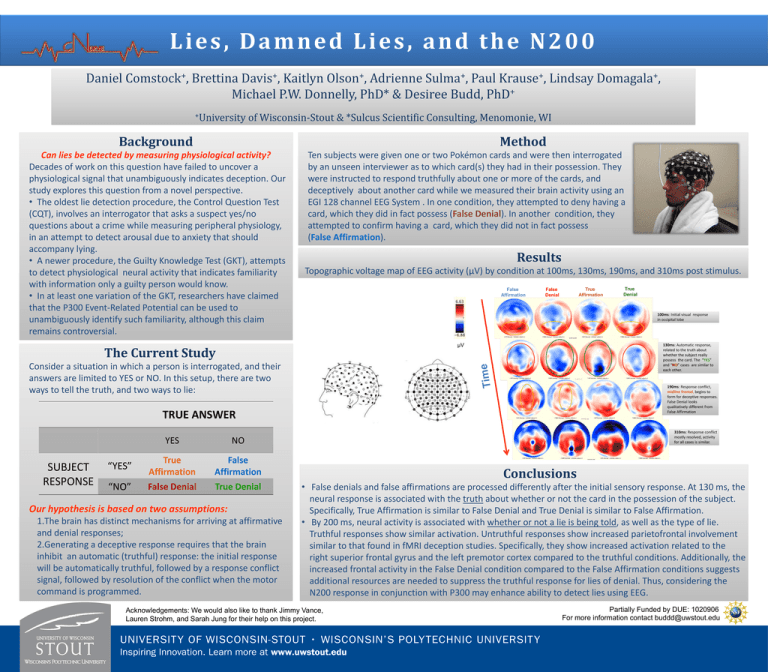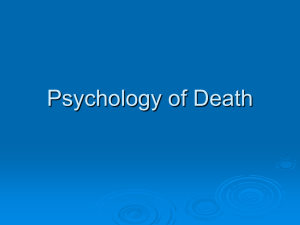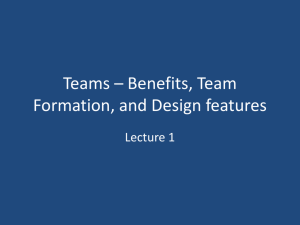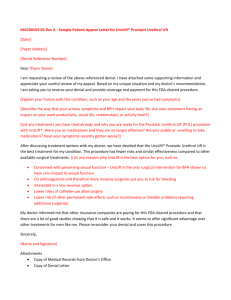Lies, Damned Lies, and the N200
advertisement

Lies, Damned Lies, and the N200 Daniel + Comstock , + Davis , Brettina Kaitlyn Adrienne Paul + Michael P.W. Donnelly, PhD* & Desiree Budd, PhD +University + Olson , + Sulma , + Krause , Lindsay + Domagala , of Wisconsin-Stout & *Sulcus Scientific Consulting, Menomonie, WI Background Method Can lies be detected by measuring physiological activity? Decades of work on this question have failed to uncover a physiological signal that unambiguously indicates deception. Our study explores this question from a novel perspective. • The oldest lie detection procedure, the Control Question Test (CQT), involves an interrogator that asks a suspect yes/no questions about a crime while measuring peripheral physiology, in an attempt to detect arousal due to anxiety that should accompany lying. • A newer procedure, the Guilty Knowledge Test (GKT), attempts to detect physiological neural activity that indicates familiarity with information only a guilty person would know. • In at least one variation of the GKT, researchers have claimed that the P300 Event-Related Potential can be used to unambiguously identify such familiarity, although this claim remains controversial. Ten subjects were given one or two Pokémon cards and were then interrogated by an unseen interviewer as to which card(s) they had in their possession. They were instructed to respond truthfully about one or more of the cards, and deceptively about another card while we measured their brain activity using an EGI 128 channel EEG System . In one condition, they attempted to deny having a card, which they did in fact possess (False Denial). In another condition, they attempted to confirm having a card, which they did not in fact possess (False Affirmation). Results Topographic voltage map of EEG activity (µV) by condition at 100ms, 130ms, 190ms, and 310ms post stimulus. µV The Current Study Consider a situation in which a person is interrogated, and their answers are limited to YES or NO. In this setup, there are two ways to tell the truth, and two ways to lie: TRUE ANSWER SUBJECT RESPONSE YES NO “YES” True Affirmation False Affirmation “NO” False Denial True Denial Our hypothesis is based on two assumptions: 1.The brain has distinct mechanisms for arriving at affirmative and denial responses; 2.Generating a deceptive response requires that the brain inhibit an automatic (truthful) response: the initial response will be automatically truthful, followed by a response conflict signal, followed by resolution of the conflict when the motor command is programmed. Conclusions • False denials and false affirmations are processed differently after the initial sensory response. At 130 ms, the neural response is associated with the truth about whether or not the card in the possession of the subject. Specifically, True Affirmation is similar to False Denial and True Denial is similar to False Affirmation. • By 200 ms, neural activity is associated with whether or not a lie is being told, as well as the type of lie. Truthful responses show similar activation. Untruthful responses show increased parietofrontal involvement similar to that found in fMRI deception studies. Specifically, they show increased activation related to the right superior frontal gyrus and the left premotor cortex compared to the truthful conditions. Additionally, the increased frontal activity in the False Denial condition compared to the False Affirmation conditions suggests additional resources are needed to suppress the truthful response for lies of denial. Thus, considering the N200 response in conjunction with P300 may enhance ability to detect lies using EEG. Acknowledgements: We would also like to thank Jimmy Vance, Lauren Strohm, and Sarah Jung for their help on this project. Partially Funded by DUE: 1020906 For more information contact buddd@uwstout.edu




